An Investigation of Wood Baseball Bat Durability as a Function of Bat Profile and Slope of Grain Using Finite Element Modeling and Statistical Analysis
Abstract
:1. Introduction
2. Materials and Methods
2.1. Wood
2.2. Baseball Bat Profiles
2.3. Finite Element Analysis
2.4. Impact Locations
2.5. Wood Failure
2.6. Failure Probability Analysis
2.7. Probability Analysis
3. Results & Discussion
4. Conclusions
Supplementary Materials
Author Contributions
Funding
Data Availability Statement
Acknowledgments
Conflicts of Interest
Appendix A. LS-DYNA Material Properties Used in Finite Element Modeling
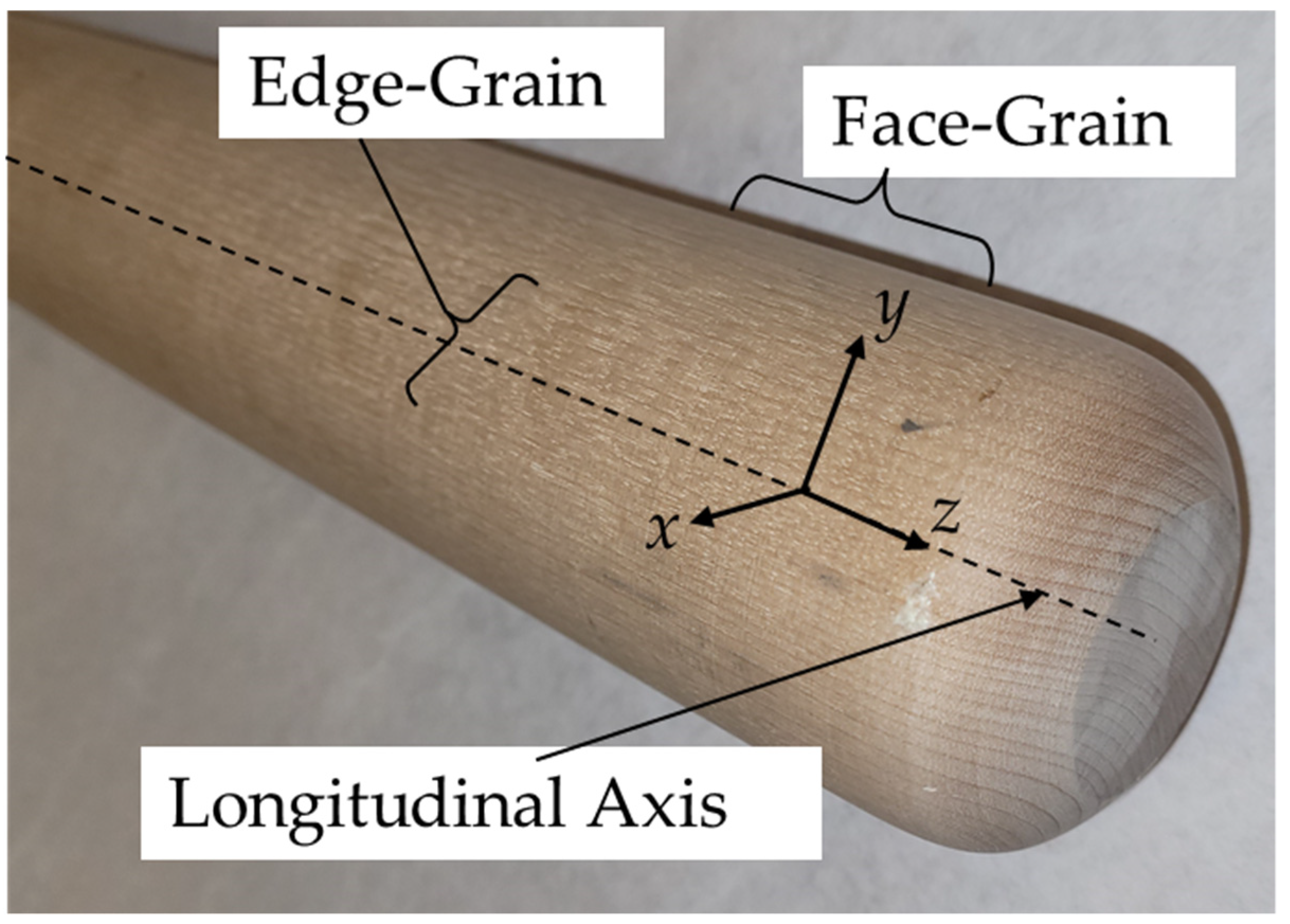
| Material Property | LS-DYNA Material Variable | Unit | Profile A | Profile B | Profile C | Profile D |
|---|---|---|---|---|---|---|
| Volume | - | in3 | 79.7 | 84.2 | 82.2 | 90.4 |
| Density | RO | lb/in3 | 0.0243 | 0.0230 | 0.0236 | 0.0214 |
| Strain-To-Failure | MAXEPS | - | 0.0234 | 0.0223 | 0.0227 | 0.0208 |
| Parallel Normal Modulus | EL | psi | 2,250,424 | 2,198,507 | 2,220,880 | 2,135,444 |
| Perpendicular Normal Modulus | ET | psi | 146,278 | 142,903 | 144,357 | 138,804 |
| Parallel Shear Modulus | GLT | psi | 249,797 | 244,034 | 246,518 | 237,034 |
| Perpendicular Shear Modulus | GTR | psi | 79,666 | 77,828 | 78,620 | 75,596 |
| Poisson’s Ratio | PR | - | 0.476 | 0.476 | 0.476 | 0.476 |
| Parallel Tensile Strength | XT | psi | 21,821 | 20,518 | 21,079 | 18,936 |
| Parallel Compressive Strength | XC | psi | 10,882 | 10,232 | 10,512 | 9443 |
| Perpendicular Tensile Strength | YT | psi | 2097 | 1972 | 2026 | 1820 |
| Perpendicular Compressive Strength | YC | psi | 2043 | 1921 | 1974 | 1773 |
| Parallel Shear Strength | SXY | psi | 3238 | 3045 | 3128 | 2810 |
| Perpendicular Shear Strength | SYZ | psi | 4534 | 4263 | 4380 | 3937 |
| Material Property | LS-DYNA Material Variable | Unit | Profile A | Profile B | Profile C | Profile D |
|---|---|---|---|---|---|---|
| Volume | - | cm3 | 1306.0 | 1379.8 | 1347.0 | 1481.4 |
| Density | RO | g/cm3 | 0.673 | 0.637 | 0.653 | 0.592 |
| Strain-To-Failure | MAXEPS | - | 0.0234 | 0.0223 | 0.0227 | 0.0208 |
| Parallel Normal Modulus | EL | MPa | 15,516.1 | 15,158.2 | 15,312.4 | 14,723.4 |
| Perpendicular Normal Modulus | ET | MPa | 1008.6 | 985.3 | 995.3 | 957.0 |
| Parallel Shear Modulus | GLT | MPa | 1722.3 | 1682.6 | 1699.7 | 1634.3 |
| Perpendicular Shear Modulus | GTR | MPa | 549.3 | 536.6 | 542.1 | 521.2 |
| Poisson’s Ratio | PR | - | 0.476 | 0.476 | 0.476 | 0.476 |
| Parallel Tensile Strength | XT | MPa | 150.5 | 141.5 | 145.3 | 130.6 |
| Parallel Compressive Strength | XC | MPa | 75.0 | 70.5 | 72.5 | 65.1 |
| Perpendicular Tensile Strength | YT | MPa | 14.5 | 13.6 | 14.0 | 12.5 |
| Perpendicular Compressive Strength | YC | MPa | 14.1 | 13.2 | 13.6 | 12.2 |
| Parallel Shear Strength | SXY | MPa | 22.3 | 21.0 | 25.6 | 19.4 |
| Perpendicular Shear Strength | SYZ | MPa | 31.3 | 29.4 | 30.2 | 27.1 |
References
- Tinkler-Davies, B.; Ramage, M.H.; Shah, D.U. Replacing willow with bamboo in cricket bats. Proc. Inst. Mech. Eng. Part P J. Sports Eng. Technol. 2021, 17543371211016592. [Google Scholar] [CrossRef]
- Fahey, G.J.; Hassett, L.P.; Brádaigh, C.M. Mechanical analysis of equipment for the game of hurling. Sports Eng. 1998, 1, 3–16. [Google Scholar] [CrossRef]
- Knowles, S.; Mather, J.; Brooks, R. Cricket Bat design and analysis through impact vibration modelling. In The Engineering of Sport; Balkema: Rotterdam, The Netherlands, 1996; pp. 339–344. [Google Scholar]
- Jensen, D. The Timeline History of Baseball; Thunder Bay Press: San Diego, CA, USA, 2020. [Google Scholar]
- Guerrieri, V. How Maple Bats Kicked Ash and Conquered Baseball. Deadspin. 28 August 2018. Available online: https://deadspin.com/how-maple-bats-kicked-ash-and-conquered-baseball-1828559282 (accessed on 17 December 2020).
- Thompson, A. The Science Behind Breaking Baseball Bats Live Science, Future US, Inc. 15 July 2008. Available online: https://www.livescience.com/2699-science-breaking-baseball-bats.html (accessed on 21 January 2021).
- Major League Baseball. Safety and Health Advisory Committee Conducts First Meeting; Major League Baseball: New York, NY, USA, 2008. [Google Scholar]
- Major League Baseball. MLB, MLBPA Adopt Recommendations of Safety and Health Advisory Committee; Major League Baseball: New York, NY, USA, 2008. [Google Scholar]
- Saraceno, J. Taking a Swing as Safer Bats. USA Today, 15 August 2016. [Google Scholar]
- Drane, P.; Sherwood, J.; Colosimo, R.; Kretchmann, D. A study of wood baseball bat breakage. Procedia Eng. 2012, 34, 616–621. [Google Scholar] [CrossRef] [Green Version]
- Ruggiero, E.; Sherwood, J.; Drane, P.; Kretschmann, D. An investigation of bat durability by wood species. Procedia Eng. 2012, 34, 427–432. [Google Scholar] [CrossRef] [Green Version]
- Ruggiero, E.; Sherwood, J.; Drane, P.; Duffy, M.; Kretschmann, D. Finite Element Modeling of Wood Bat Profiles for Durability. Procedia Eng. 2014, 72, 527–532. [Google Scholar] [CrossRef] [Green Version]
- Drane, P.; Fortin-Smith, J.; Sherwood, J.; Kretschmann, D. Predict the Relationship Between Wood Baseball Bat Profile and Durability. Procedia Eng. 2016, 147, 425–430. [Google Scholar] [CrossRef] [Green Version]
- Fortin-Smith, J.; Sherwood, J.; Drane, P.; Kretschmann, D. A Finite Element Investigation of the Relationship Between Bat Taper Geometry and Bat Durability. Procedia Eng. 2016, 147, 419–424. [Google Scholar] [CrossRef] [Green Version]
- Fortin-Smith, J.; Sherwood, J.; Drane, P.; Ruggiero, E.; Campshure, B.; Kretschmann, D. A Finite Element Investigation into the Effect of Slope of Grain on Wood Baseball Bat Durability. Available online: https://www.mdpi.com/2076-3417/9/18/3733 (accessed on 17 December 2020).
- Fortin-Smith, J.; Sherwood, J.; Drane, P.; Kretschmann, D. Characterization of Maple and Ash Material Properties as a Function of Wood Density for Bat/Ball Impact Modeling in LS-DYNA. Procedia Eng. 2016, 147, 413–418. [Google Scholar] [CrossRef] [Green Version]
- Drane, P.J.; Sherwood, J.A.; Shaw, R.H. An Experimental Investigation of Baseball Bat Durability. In The Engineering of Sport 6; Moritz, E.F., Haake, S., Eds.; Springer: New York, NY, USA, 2006; pp. 5–10. [Google Scholar]
- Campshure, B.; Drane, P.; Sherwood, J. An Investigation of Maple Wood Baseball Bat Durability as a Function of Bat Profile Using LS-DYNA. In Proceedings of the 16th International LS-DYNA Users Conference, 10–11 June 2020; Available online: https://www.dynalook.com/conferences/16th-international-ls-dyna-conference/modeling-t11-1/t11-1-c-modeling-062.pdf (accessed on 21 January 2021).
- Trentacoste, M.F. Manual for LS-DYNA Wood Material Model 143; p. 166. Available online: https://rosap.ntl.bts.gov/view/dot/35895/dot_35895_DS1.pdf?download-document-submit=Download (accessed on 21 January 2021).
- Marray, Y.D.; Reid, J.D.; Faller, R.K.; Bielenberg, B.W.; Paulsen, T.J. Evaluation of LS-DYNA Wood Material Model 143; Federal Highway Adminstration: Washington, DC, USA, 2005.
- LivermoreSoftware Technology (LST). LS-DYNA Keyword User’s Manual. 2020. Available online: https://www.dynasupport.com/manuals/ls-dyna-manuals/ls-dyna_manual_volume_ii_r12.pdf (accessed on 21 January 2021).

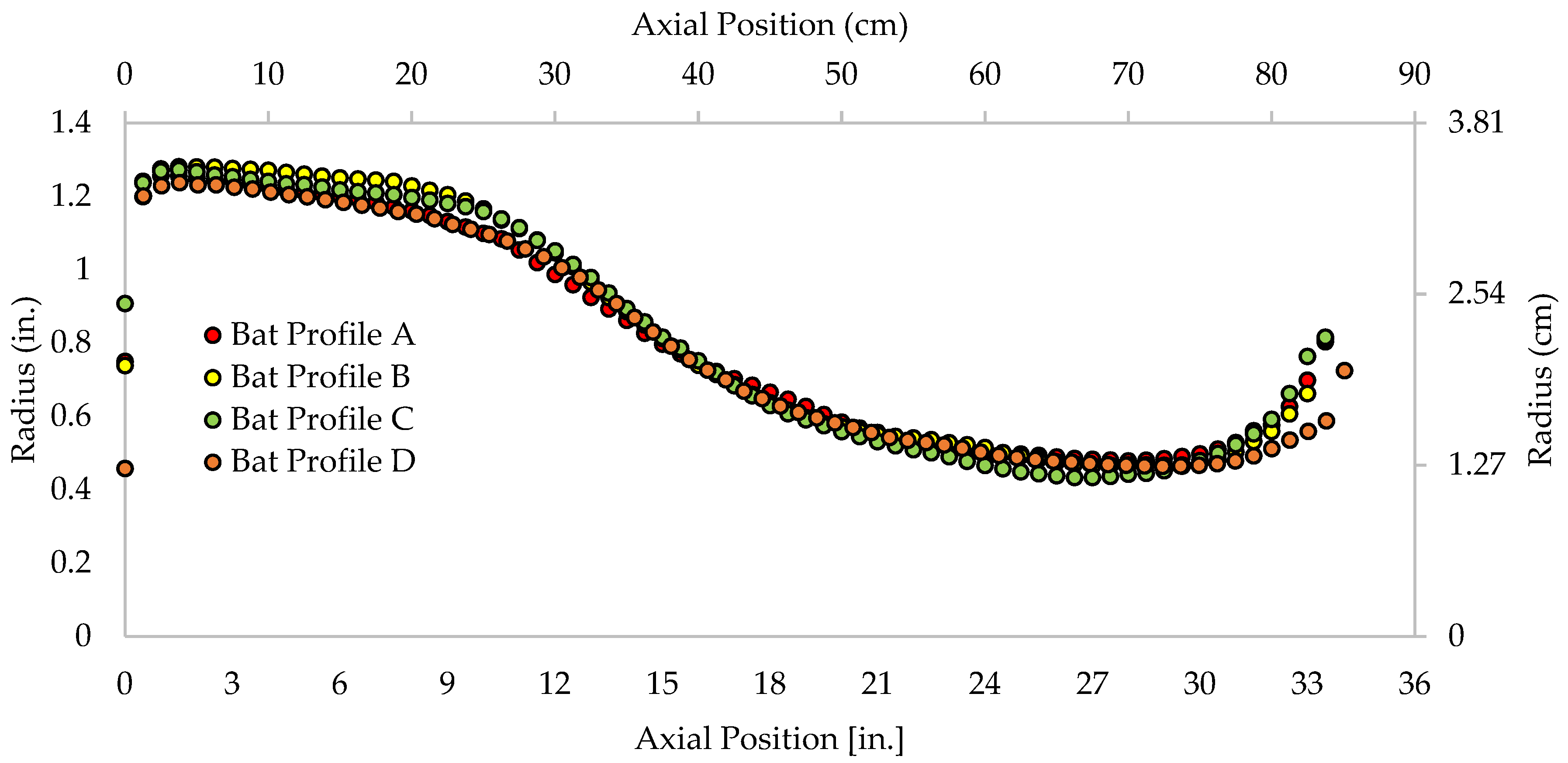

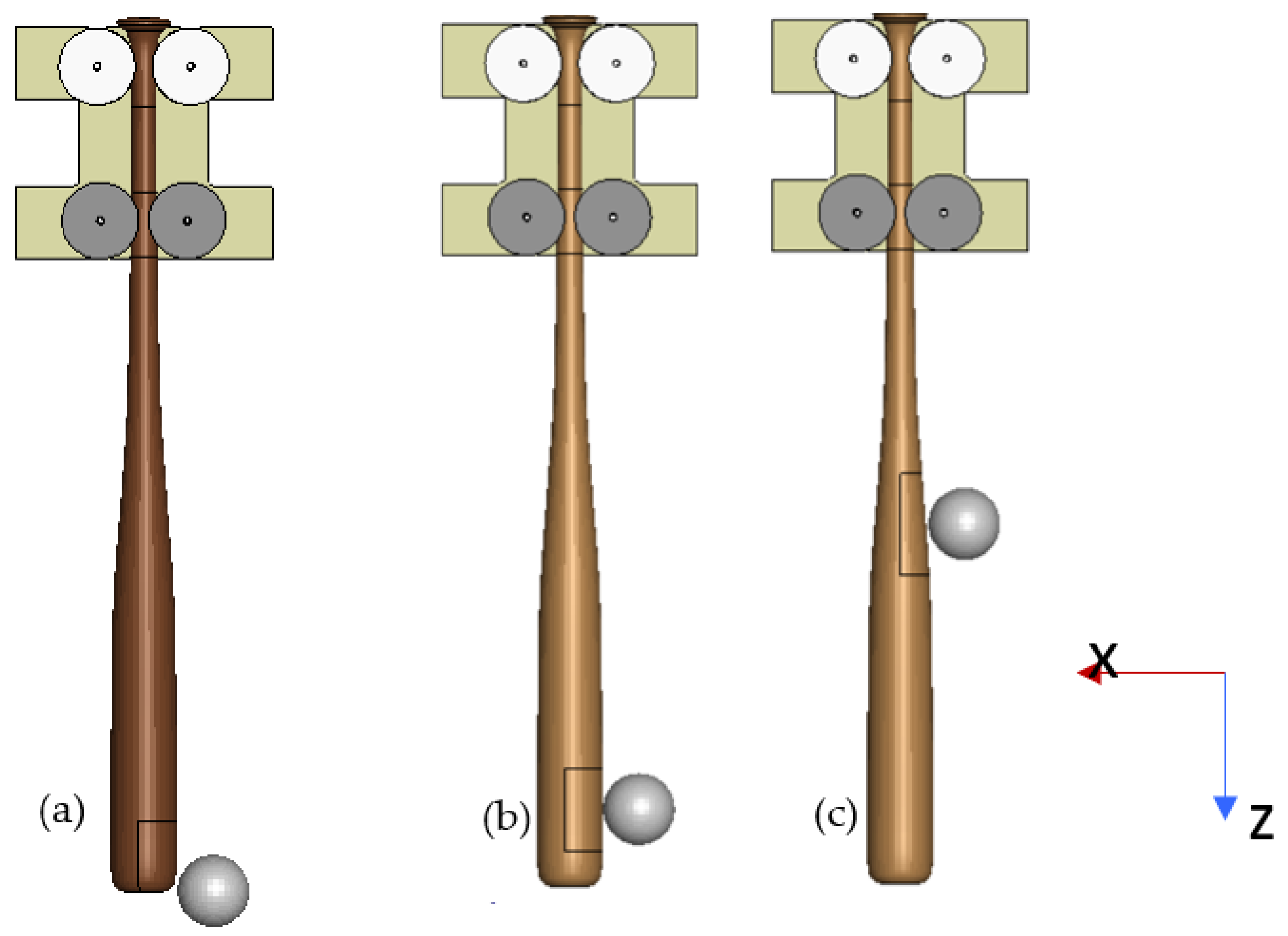

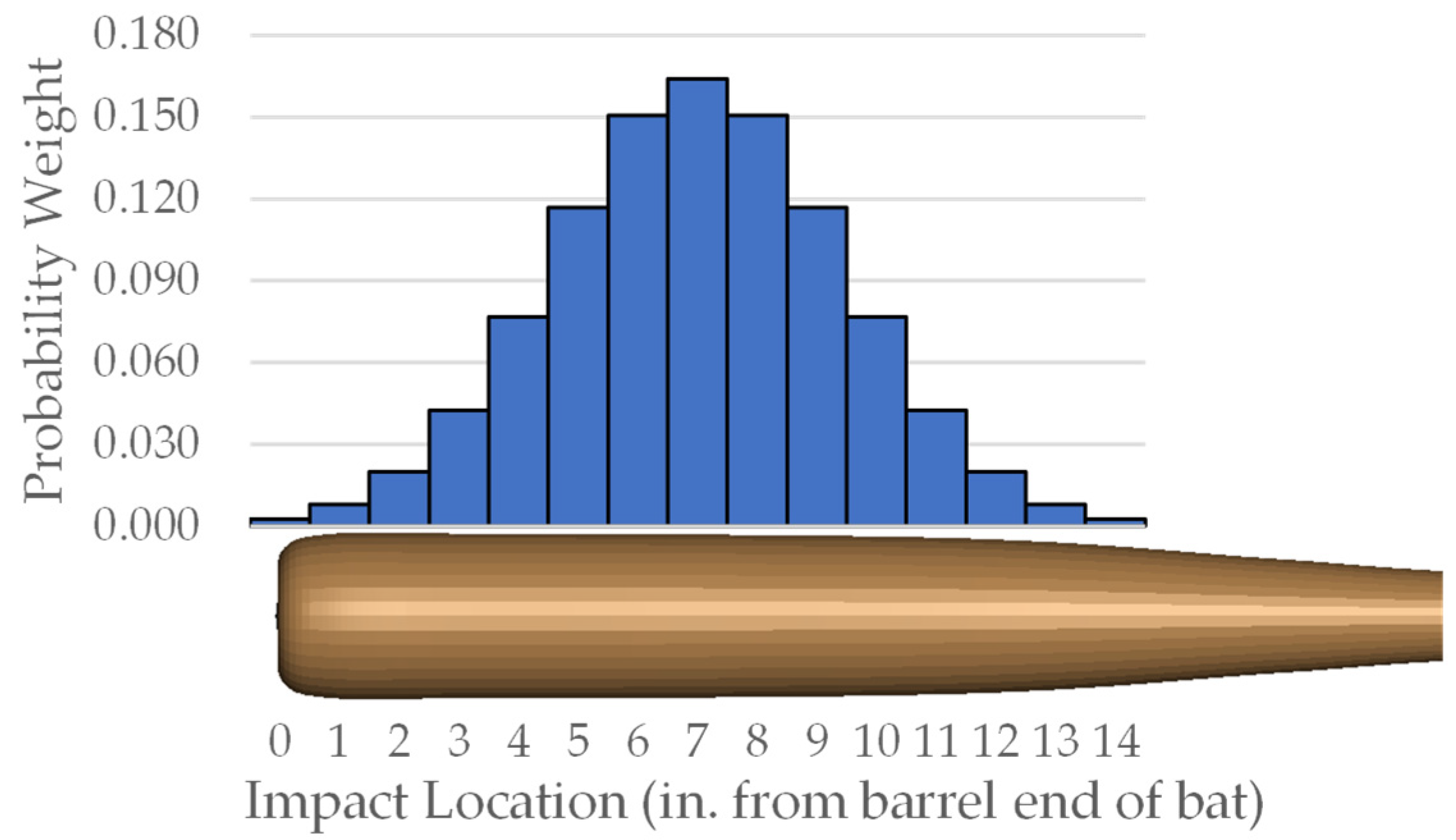
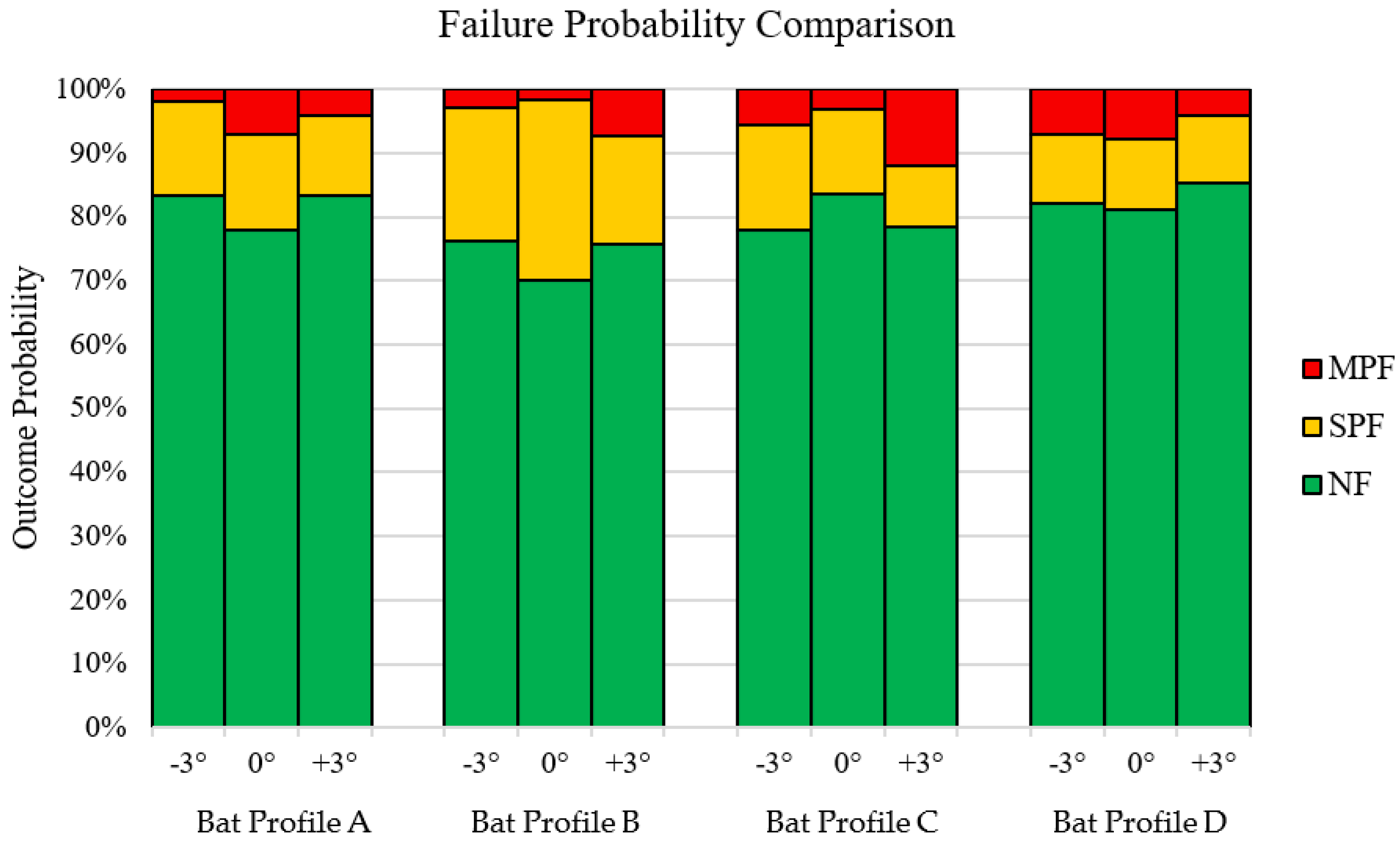

| Profile | Volume | Density | Min Handle Diameter | Max Barrel Diameter | 6-Inch Sweet Spot Diameter | 11-Inch Transition Diameter | ||||||
|---|---|---|---|---|---|---|---|---|---|---|---|---|
| in3 (cm3) | lb/in3 (g/cm3) | in. (cm) | in. (cm) | in. (cm) | in. (cm) | |||||||
| A | 79.7 | (1306) | 0.0243 | (0.673) | 0.479 | (1.217) | 1.257 | (3.193) | 1.201 | (3.051) | 1.054 | (2.677) |
| B | 84.2 | (1380) | 0.0230 | (0.637) | 0.465 | (1.181) | 1.281 | (3.254) | 1.251 | (3.178) | 1.112 | (2.824) |
| C | 82.2 | (1347) | 0.0236 | (0.672) | 0.434 | (1.102) | 1.273 | (3.233) | 1.218 | (3.093) | 1.115 | (2.832) |
| D | 90.4 | (1481) | 0.0214 | (0.592) | 0.497 | (1.262) | 1.326 | (3.368) | 1.269 | (3.223) | 1.133 | (2.878) |
| Bat Profile | Mean Values | Standard Deviation | ||||
|---|---|---|---|---|---|---|
| NF% | SPF% | MPF% | NF% | SPF% | MPF% | |
| A | 81.5 | 14.2 | 4.3 | 3.1 | 1.3 | 2.5 |
| B | 74.1 | 21.9 | 4.0 | 3.4 | 5.7 | 2.9 |
| C | 80.0 | 13.1 | 6.9 | 3.1 | 3.5 | 4.5 |
| D | 82.9 | 10.7 | 6.4 | 2.2 | 0.2 | 2.0 |
Publisher’s Note: MDPI stays neutral with regard to jurisdictional claims in published maps and institutional affiliations. |
© 2022 by the authors. Licensee MDPI, Basel, Switzerland. This article is an open access article distributed under the terms and conditions of the Creative Commons Attribution (CC BY) license (https://creativecommons.org/licenses/by/4.0/).
Share and Cite
Campshure, B.; Drane, P.; Sherwood, J.A. An Investigation of Wood Baseball Bat Durability as a Function of Bat Profile and Slope of Grain Using Finite Element Modeling and Statistical Analysis. Appl. Sci. 2022, 12, 3494. https://doi.org/10.3390/app12073494
Campshure B, Drane P, Sherwood JA. An Investigation of Wood Baseball Bat Durability as a Function of Bat Profile and Slope of Grain Using Finite Element Modeling and Statistical Analysis. Applied Sciences. 2022; 12(7):3494. https://doi.org/10.3390/app12073494
Chicago/Turabian StyleCampshure, Blake, Patrick Drane, and James A. Sherwood. 2022. "An Investigation of Wood Baseball Bat Durability as a Function of Bat Profile and Slope of Grain Using Finite Element Modeling and Statistical Analysis" Applied Sciences 12, no. 7: 3494. https://doi.org/10.3390/app12073494






